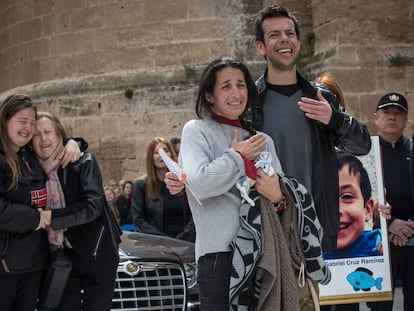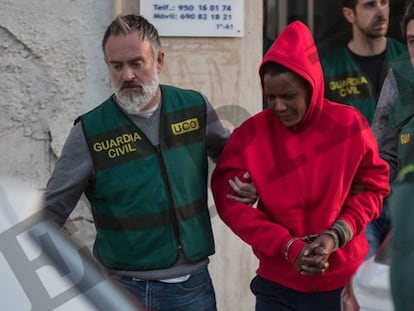“Ana Julia Quezada is an incredibly cold, possessive and egocentric person”
Spanish Civil Guard explains details of the murder of eight-year-old Gabriel Cruz at the hands of his father’s girlfriend

The Spanish Civil Guard has explained the details concerning the investigation into the murder of Gabriel Cruz, an eight-year-old boy who was murdered by his father’s girlfriend Ana Julia Quezada. Speaking at a press conference, Juan Jesús Reina, the head of the Central Operation Unit explained: “The child died from asphyxiation,” but refused to go into “unnecessary details” for the sake of the family and the boy’s memory.
“We can make many hypotheses but sadly the truth is the only two people who know how Ana Julia Quezada took Gabriel are Ana Julia Quezada and Gabriel,” he said.
She had a strange attitude when the family suggested raising the award for anyone who found him or provided clues Lieutenant colonel José Hernández Mosquera
Gabriel went missing from his home town in southern Spain’s Almería province on February 27. His body was found 12 days later in the trunk of Quezada’s car. On Tuesday, Quezada confessed to the crime but said she acted in self defense. She claimed that the youngster got angry with her and attacked her with a hatchet. She told investigators that she then hit the boy with the blunt part of the tool, leaving him unconscious. In a state of panic, she then strangled him, stripping him of his clothes and burying the body.
At the press conference, Reina dismissed this argument. “There is an important fact although it has no legal value … Gabriel could never make the kinds of comments she has referred to because he was taught to love and respect others.
“Ana Julia Quezada is an incredibly cold, possessive and egocentric person,” he added.
Reina explained that the investigation quickly began to suspect that Quezada was involved but never expressed this to the boy’s father, Ángel Cruz, or his mother.
“She had a strange attitude when the family suggested raising the award for anyone who found him or provided clues to his whereabouts. That made us suspicious,” said Lieutenant Colonel José Hernández Mosquera.
Mosquera said a “key moment” came when Quezada found the boy’s shirt in a remote area four kilometers from the family’s farm Las Hortichuelas: “She is the one who said to Ángel, ‘Let’s look in this area.’ And it was her, not Ángel, who found the shirt.”
Of course we cried. Anyone who didn’t cry then, cried later Civil Guard investigator Juan Jesús Reina
He explained that police suspected Quezada planted the shirt in an effort to implicate her ex-boyfriend, who lived in the area. From that moment on, the line of investigation centered on Quezada, he says. She was put under surveillance and police saw that she frequently visited a home in Rodalquilar, five kilometers from the family’s farm. There, they watched as she put the boy’s body in the trunk of her car. Quezada was later arrested and while initially denying the crime, late confessed to murder. At the press conference, Mosquera confirmed that the Civil Guard investigators do not believe any third parties were involved with the crime: “The only culprit is Ana Julia and she did it alone.”
The operation to find Gabriel was dubbed Operation Nemo in homage to the child who was affectionately known as “Pescadito,” or Little Fish, said Reina. Around 3,000 volunteers took part in the search effort.
Reina said the entire team had been hit hard by the case. “We were looking for Gabriel alive… discovering that Gabriel was dead was the hardest moment in our careers. Of course we cried. Anyone who didn’t cry then, cried later. We are human beings.”
English version by Melissa Kitson.
Tu suscripción se está usando en otro dispositivo
¿Quieres añadir otro usuario a tu suscripción?
Si continúas leyendo en este dispositivo, no se podrá leer en el otro.
FlechaTu suscripción se está usando en otro dispositivo y solo puedes acceder a EL PAÍS desde un dispositivo a la vez.
Si quieres compartir tu cuenta, cambia tu suscripción a la modalidad Premium, así podrás añadir otro usuario. Cada uno accederá con su propia cuenta de email, lo que os permitirá personalizar vuestra experiencia en EL PAÍS.
¿Tienes una suscripción de empresa? Accede aquí para contratar más cuentas.
En el caso de no saber quién está usando tu cuenta, te recomendamos cambiar tu contraseña aquí.
Si decides continuar compartiendo tu cuenta, este mensaje se mostrará en tu dispositivo y en el de la otra persona que está usando tu cuenta de forma indefinida, afectando a tu experiencia de lectura. Puedes consultar aquí los términos y condiciones de la suscripción digital.
More information
Archived In
Últimas noticias
Mexico seeks to shore up its defenses following US incursion in Venezuela
Hope gives way to uncertainty among Venezuelan exiles in the US after Maduro’s capture
Cubans look to Venezuela fearfully after Trump’s incursion: ‘We could be next’
The operation in Venezuela to capture Maduro threatens to widen the cracks in the MAGA movement
Most viewed
- Alain Aspect, Nobel laureate in physics: ‘Einstein was so smart that he would have had to recognize quantum entanglement’
- Gilles Lipovetsky: ‘If you want to live better and fall in love, take Prozac, don’t look to philosophy’
- Alvin Hellerstein, a 92-year-old judge appointed by Bill Clinton, to preside over Maduro’s trial in New York
- Cuba confirms death of 32 of its citizens in the US attack against Venezuela
- Why oil has been at the center of Venezuela-US conflicts for decades










































